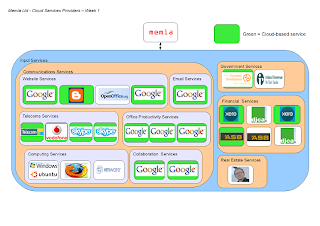OK, I'm at the end of month 1 of setting up the business from scratch, and have begun operating the business (Memia Ltd) and trading. It's an exciting time!
I thought I'd share some of the initial architectural outputs of this exercise - effectively as time goes on I will provide an ongoing commentary on how Memia is putting together a "Cloud Services Enterprise Architecture" for a small services business (with growth ambitions!). Hopefully the experience and techniques will be generic enough to be useful for others doing the same thing. This is, after all, our core business. ;-)
The diagram below shows the first iteration of Memia's cloud services architecture. (Click for bigger picture).

First off, I have divided the cloud services diagram into two main groupings, with the business in the middle: Output Services and Input Services: basically, the business consumes a set of services, and most importantly provides the "secret sauce" which enables the output services to be provided.
You can see from the Output Services box that the actual revenue-generating services are a pretty small part of the overall operational complexity of running a small business - in addition to earning money doing the day job, the business has to provide marketing, communications, regulatory compliance, day-to-day financial operations, and be set up to look after shareholders as well. These groupings are my first attempt at defining what a generic "baseline" business must do in order to get trading - I am sure there will be plenty more that I come across as the business grows...
The Input Services box illustrates all of the services that I have begun using during the setup over the last few weeks. As a matter of principle (and to eat my own dogfood!) I have used Cloud-based services wherever I can (shaded Green) - luckily(lazily) I have been able to delegate most of the complexity in my Enterprise to Google Apps - for free! - something that wasn't possible even a year ago. If you look at the diagram below, you can see the service providers I have chosen (for a business based in New Zealand).

- Home office space provided by yours truly ;-)
So I'm going to keep iterating this model and add new input and output services according to the business strategy - I'm also going to try to generate some traceability between the output services and the input services - this will be a good way to shake out the dependencies and business processes involved. I haven't followed any formal methodology (because life's too short in the real world) - however, I reckon this "services in, services out" technique is a pretty effective "agile" methodology for small businesses. I'm interested in anyone's comments here...






